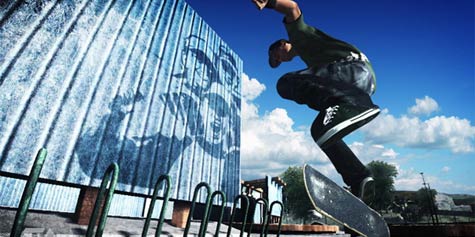-
"There are many things about my youth that have been ground into fine dust by a relentless online culture determined to use every emotion I've ever felt as a wedge into CPM advertising or a dubstep meme remix.
This is not one of them."
-
"I keep reading books and seeing movies where nobody can fucking say anything except fuck, unless they say shit. I mean they don’t seem to have any adjective to describe fucking except fucking even when they’re fucking fucking. And shit is what they say when they’re fucked. When shit happens, they say shit, or oh shit, or oh shit we’re fucked. The imagination involved is staggering. I mean, literally." Ursula LeGuin on obscenity, swearing, and the way it's used on contemporary media. (LeGuin is someone who, for reference, has always used language precisely and carefully; she is not a prude, just bored of a lack of imagination.)
-
This large image (4400×2364 pixels) is completely marvellous: a genuine history, reaching back into trends from the dawn of literature, and with a healthy chunk of 19th century gothic/mystery in there. Makes me very happy, especially in terms of fond memories of books I've enjoyed.
-
"The first 5 summoners who received 1+ week suspensions who reply to this thread – I will reply to your post with additional details explaining the suspension." Great thread: trollers and griefers ask to know why they received bans, understanding that the complaints against their names will be revealed in public. Then, some of them appear confused as to precisely why their crimes were considered so. Interesting piece of transparency from the LOL staff.
-
Shutterbug vs the Super Metroid soundtrack, from the new Team Teamwork joint. Oh yes.
-
It's Mario. And then it's Tetris. And then it's Mario. And then it's Tetris. Copyright-infringing Flixel awesomeness – much better than the concept initially sounds. You should check this out.
-
There is nothing about this that is not amazing.
-
"…halfway through the film, the Ghostbusters realize that NYNEX isn't a phone system at all: it's the embedded nervous system of an angel – a fallen angel – and all those phone calls and dial-up modems in college dorm rooms and public pay phones are actually connected into the fiber-optic anatomy of a vast, ethereal organism that preceded the architectural build-up of Manhattan. Manhattan came afterwards, that is: NYNEX was here first." There is no way this wouldn't be awesome. And: a great write-up from Geoff.
-
How to compile APC into the Marc Liyanage PHP5 package (which is clearly the most sensible one to be using on OSX). Though this is for Server, it works fine on desktop, and as such comes recommended.
-
"This toaster was built from scratch by Thomas Thwaites, a design student at the Royal College of Art, London, as a project in extreme self-sufficiency and to highlight the effects of mass production we take for granted." And this is what it looks like.
-
"I'm Thomas Thwaites and I'm trying to build a toaster, from scratch – beginning by mining the raw materials and ending with a product that Argos sells for only £3.99. A toaster." This is clearly amazing, and a timely reminder of, you know, what the age of mass production really means.
-
More on the phenomenon that is Ken Fighter Ken.
-
This is a pretty accurate explanation of the state of the majority of SF4 online. It's also quite funny, and is the reason the phrase "Flowchart Ken", used to described a particular kind of player, is already entering the SF4 Lexicon.
-
"Ryanair can confirm that a Ryanair staff member did engage in a blog discussion. It is Ryanair policy not to waste time and energy corresponding with idiot bloggers and Ryanair can confirm that it won't be happening again." Ryanair's social media strategy is pretty much on-brand, it seems.
-
'A morose-looking guy stood at the bar talking to his friends, wearing a Flashbang Studios t-shirt. Emily leaned across the bar next to him, and shouted giddily over the music: "hey, I like that developer."' A lovely piece of speculative writing from Duncan Fyfe.
-
A first, rather long, post on the S&W Blog, in which I talk to Jack about a project he's been working on for a while.
-
"This summer will you be, or not be? It's Resident Evil meets House of the Dead, IN DENMARK." Epic Eegra thread taking the Dante's Inferno-shaped ball and running a very, very long way with it.
-
Full version, no out! The beta was lovely, so I'm looking forward to this a lot.
-
"[Wrestle Jam is] completely playable. There was an intro screen, character select, win / loss conditions, opponent AI, eight different attacks," Furino explained. "It was as close to a genuine old-school wrestling game as I could make it in the time allowed. I even mapped an old Nintendo controller to the input system so they could play it that way." Gosh, that's lovely, if not totally unexpected from Arronofsky. Lovely interview, too.
-
"Not to be outdone (well, maybe a little outdone), we've combed through hours of imaginary data here at Consumerist HQ and put together a similar animation that illustrates Starbucks' explosive growth over the past 20 years. Enjoy." I did.
-
Obvious, when you think about it; if you're going to mash up one track in five, why not find another? What's remarkable is how well Brubeck's piano and Paul Desmond's sax fit the melody, as well as the stilted rhythm, of Radiohead's "Fifteen Step".
-
"SmartSwitch doesn't restrict the user from turning on a light, but rather it passively encourages behavior change. SmartSwitches can be programmed to respond to either personal or communal electrical usage. In a home wired with SmartSwitches, lights can become harder to turn on during hours of peak demand." Just right.
-
"When NASA's last scheduled Space Shuttle mission lands in June of 2010, the United States will not have the capability to get astronauts into space again until the scheduled launch of the new Orion spacecraft in 2015. Over those five years, the U.S. manned space program will be relying heavily on Russia and its Baikonur Cosmodrome facility in Kazakhstan." Wonderful pictures of spaceflight, Russian-style.
-
"Journalist Kareem Shaheen was attending at GAMES 2008 convention in Dubai, and asked us if we fancied writing anything about gaming in the Middle East. And we said HELL YES, as we like capitals." A nice, if brief, piece from Shaheen about a sector of gaming I know nothing about.
-
Make Iced Tea!
-
"Now noisy makers can assemble and modify their own light controlled analog noise friend!" I want an analog noise friend.
-
"Over the weekend, students from NYC's Parsons School worked for twenty four hours continuously with LittleBigPlanet. Their challenge? To create a level from scratch using early copies of the PS3-exclusive.. one level stood out as the single best level — one created by Team Sportsmanship. We've lovingly dubbed the level "Shadow of the LittleBigColossus." Watch the video and see why." Amazing. Intensive, over-difficult, but still impressive.
Skate: Gaming for Generation C
05 January 2008

I’ve been meaning to talk about EA’s Skate for a while.
Skate is a wonderful game. Whilst the Tony Hawk games plough ever-deeper furrows of furious button-mashing combos, EA decided to go for a more “realistic” route with their skateboarding game. The controls are the most obvious example of this: rather than using buttons to correspond to moves, they use the analogue controls on the board to correspond to the rider’s body: the left stick is your body, the right your feet; the two shoulder buttons are two hands.
To Ollie, you flick the right stick from neutral, to down, to up. To kickflip it’s neutral to down to up/left or up/right. To manual – rolling on only the front or rear set of wheels – you have to find a sweet-spot on the right stick and not move it to neutral or an extremity; as in life, it’s a balance problem. Here’s a more detailed look at the “Flickit” trick scheme.
Couple that approach with a somewhat heavier gravity than Hawk ever had, and you end up with a wonderful simulation of skateboarding. It places the focus not on huge chain-combos (a “videogamey” aesthetic if ever there was one) but on simple, stylish maneuvers that look cool. It’s very satisfying to pull off a simple flip-to-grind, as long as the line is good and you look good doing it. All of a sudden, the focus shifts from points, to just how good you can look navigating the city (a fictional hybrid called “San Vanelona”).
So far, so good. But for me, the most interesting thing about the game is what happens when the game breaks out of the console and into the world.

In order to capture stylish runs and painful bails, EA included an impressive video editor, which makes it easy to alter film-processing and speed effects to mimic the immediately recognisable skate-video aesthetic.
And these videos can be shared with friends. And not just by forwarding them over Xbox Live; no, you can shoot a video in-game, and then – from your console (PS3 or 360) – upload it to the web. EA have a dedicated site for this, called Reel. Like any Web 2.0 product, Reel is still in beta (perhaps giving it a more “authentic” feel), and it effectively functions as a miniature Youtube for the game.
Here’s a short clip of a through-flip hosted on Reel. You can see some of the film effects in play. And remember: this clip was made in a videogame, uploaded from a console, and now exists as an embedded flash movie on a webpage, with the potential to be tagged, commented, and linked to.
And EA really want people to use this. If you look at the Achievements list for the game (Achievements being a way of rewarding players for impressive, or unusual behaviour in-game), you can see that amongst the usual score and skill challenges, there are achievements for uploading videos and photos, and even one for getting at least 20 people to view your video on the web.
Think about that for a second: you get an achievement for the behaviour of other people who aren’t in the game-world at the time.
I find Skate exciting because it’s a prime example of a game that understands Generation C; it allows players to share game-information outside the game – and in a manner that is so much more easily referenced, due to it having a permanent link – just as they share movies, photos, and blogposts. Other games that “get” this include Halo 3, which lets you upload and share screengrabs, movies, and even custom game-rules (although you can only view screengrabs online), and the Project Gotham and Forza games, which have a very detailed photo mode; here’s some of my virtual photographs from PGR3.
It’s also great to see EA understanding the ethos of the real-world skate community. Skating has always been a community with a huge user-generated aspect; bootleg and home-made skate videos have been a huge part of the scene, and so to attempt to digitally recreate the community (and not just the activity) is a really interesting move.
Skate has been almost universally praised, but it doesn’t feel like it’s done as well as it could have. That’s a shame, because in many ways, it’s one of the more innovative “major league” titles of last year. For the reasons above, I thought it was worth bringing to the attention of the many people interested in this terrain who don’t necessarily play console games.